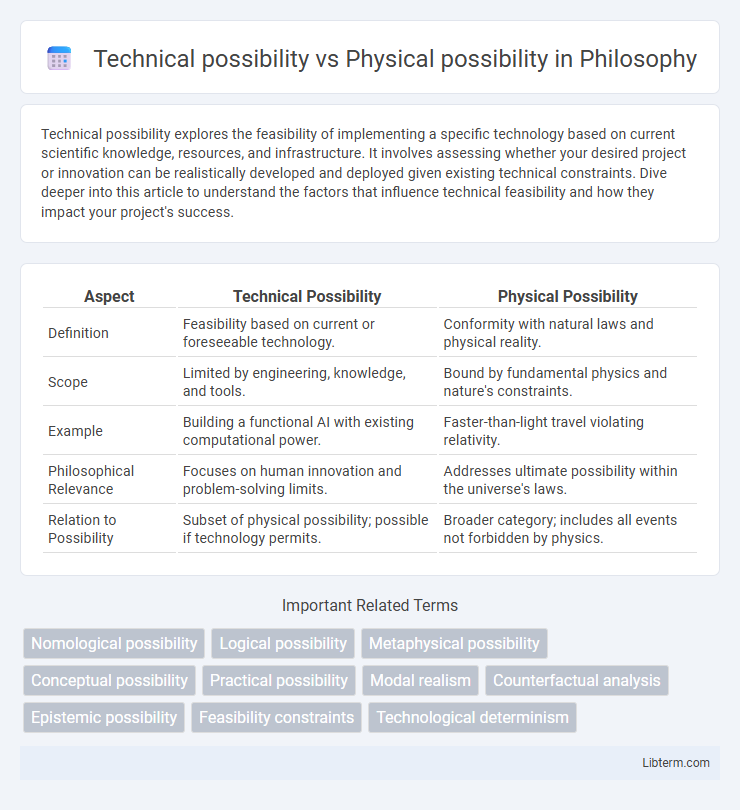Technical possibility explores the feasibility of implementing a specific technology based on current scientific knowledge, resources, and infrastructure. It involves assessing whether your desired project or innovation can be realistically developed and deployed given existing technical constraints. Dive deeper into this article to understand the factors that influence technical feasibility and how they impact your project's success.
Table of Comparison
| Aspect | Technical Possibility | Physical Possibility |
|---|---|---|
| Definition | Feasibility based on current or foreseeable technology. | Conformity with natural laws and physical reality. |
| Scope | Limited by engineering, knowledge, and tools. | Bound by fundamental physics and nature's constraints. |
| Example | Building a functional AI with existing computational power. | Faster-than-light travel violating relativity. |
| Philosophical Relevance | Focuses on human innovation and problem-solving limits. | Addresses ultimate possibility within the universe's laws. |
| Relation to Possibility | Subset of physical possibility; possible if technology permits. | Broader category; includes all events not forbidden by physics. |
Defining Technical Possibility
Technical possibility refers to the feasibility of achieving a task or outcome using current technological tools, methods, and knowledge, emphasizing practical implementation constraints rather than mere physical laws. It assesses whether existing technologies can realize a given solution within known engineering and operational parameters. This concept contrasts with physical possibility, which concerns whether something can occur without violating natural laws, independent of current technological capabilities.
Understanding Physical Possibility
Physical possibility refers to scenarios that comply with the fundamental laws of nature, such as physics and chemistry, allowing events or objects to exist or occur without defying natural constraints. It differs from technical possibility, which considers current technological capabilities and practical implementation rather than natural feasibility. Understanding physical possibility requires recognizing that while some phenomena may not be achievable with present technology, they remain feasible within the bounds of physical laws and scientific principles.
Key Differences Between Technical and Physical Possibility
Technical possibility refers to what can be achieved using current technology and scientific knowledge, while physical possibility pertains to what is feasible according to the fundamental laws of nature and physics. Key differences include that technical possibility is constrained by existing tools and methods, whereas physical possibility is limited only by natural laws, regardless of technological advancement. Consequently, some concepts may be physically possible but not technically achievable with present capabilities.
Historical Examples of Technical vs Physical Limitations
Historical examples of technical possibility versus physical possibility reveal distinct challenges in engineering and science. The Wright brothers' first powered flight in 1903 demonstrated overcoming technical limitations of engine power and aerodynamics, while physical constraints like gravity remained insurmountable to fully autonomous human flight without technology. Similarly, early 20th-century attempts at deep-sea exploration were hindered by technical limitations in pressure-resistant materials, although physical laws of water pressure still imposed absolute boundaries on submersible depth.
Role of Scientific Laws in Setting Physical Boundaries
Scientific laws establish the fundamental physical boundaries that define what is physically possible, restricting actions according to natural constants like gravity or thermodynamics. Technical possibility explores what can be achieved within these laws using current or future technology, often pushing the limits of innovation. Understanding scientific laws is crucial for distinguishing feasible technological advancements from physically impossible scenarios.
Technological Advancements Challenging Physical Limits
Technological advancements continually push the boundaries between technical possibility and physical possibility by developing materials and systems that operate at extremes previously deemed unattainable, such as quantum computing and nanotechnology. Innovations in engineering methods and adaptive technologies challenge traditional physical constraints like speed, energy efficiency, and miniaturization. Breakthroughs in fields like biomimicry and advanced robotics demonstrate how evolving technology can redefine what is physically achievable in fabrication and functionality.
Case Studies: When Technical Know-How Exceeds Physical Feasibility
Case studies in aerospace engineering illustrate scenarios where advanced technical know-how allows for innovative design concepts that surpass current physical material limitations, such as developing ultra-lightweight structures that humans cannot yet manufacture at scale. In biotechnology, gene editing techniques demonstrate precise technical capability but often confront physical constraints like cellular response or ecological impact that prevent full practical application. These examples highlight the disparity between possessing detailed technical knowledge and overcoming inherent physical feasibility challenges.
The Intersection of Engineering and Physics
Technical possibility refers to what can be achieved through engineering techniques and innovations, while physical possibility is constrained by the fundamental laws of physics and natural phenomena. The intersection of engineering and physics lies in translating theoretical physical principles into practical, implementable technologies that respect these universal constraints. Advances in materials science, thermodynamics, and quantum mechanics continually expand the realm of technical possibilities within the boundaries defined by physical laws.
Implications for Innovation and Future Development
Technical possibility refers to what can be achieved with current or anticipated technological capabilities, while physical possibility denotes what is fundamentally allowed by the laws of nature. Understanding the distinction guides innovation strategies by highlighting areas where breakthroughs in engineering can expand what is technically possible without violating physical constraints. Emphasizing technical feasibility helps allocate R&D resources efficiently, fostering advancements in fields like AI, renewable energy, and biotechnology, thereby accelerating future development.
Ethical and Practical Considerations
Technical possibility refers to the ability to achieve a task using current technology, whereas physical possibility involves the laws of nature and matter, limiting what can be realistically performed. Ethical considerations prioritize human rights, safety, and societal impact, often restricting technical possibilities despite physical feasibility. Practical considerations include resource availability, cost, and scalability, which determine whether technically and physically possible actions can be responsibly implemented.
Technical possibility Infographic

 libterm.com
libterm.com